Difference between revisions of "Dark period"
m (add link to dark red goggles) |
|||
| Line 23: | Line 23: | ||
!Verdict | !Verdict | ||
!Sample Image | !Sample Image | ||
| + | !Sample Link(Aliexpress.com) | ||
|- | |- | ||
|Light red | |Light red | ||
| Line 29: | Line 30: | ||
|Recommended | |Recommended | ||
|[[File:Light red goggles.png|frameless|253x253px]] | |[[File:Light red goggles.png|frameless|253x253px]] | ||
| + | | | ||
|- | |- | ||
|Dark red | |Dark red | ||
| Line 35: | Line 37: | ||
|Recommended | |Recommended | ||
|[[File:Dark red goggles.png|frameless]] | |[[File:Dark red goggles.png|frameless]] | ||
| + | |https://aliexpi.com/Fkns | ||
|- | |- | ||
|Orange | |Orange | ||
Revision as of 09:36, 28 November 2020
Dark period is a way for sleepers to stabilise their circadian rhythms in the absence of long blocks of sleep and increase the quality of SWS. For most schedules, it should start 1.5-3 hours before the dusk (SWS peak) sleep block and continue for around 8 to 12 hours afterwards.
Rationale
Before the advent of electrical lighting in modern times, humans historically had a stable time during the night in which there is little light. This helps them stabilise their circadian rhythms and keeps them synced to the natural day/night cycle.
Modern humans often use electric lighting during the night. This can cause difficulty sleeping, as the body thinks it is still daytime even if it is already midnight, and is the reason why people often experience the desire to sleep later and later each day. For monophasic sleepers, a relatively stable, albeit short, dark period can be maintained during their sleep hours, which prevents their body clocks from going totally haywire.
However, for polyphasic sleepers who might not have such long sleep blocks, this poses an issue. As light is present around the clock, melatonin production is suppressed and the quality of SWS is compromised. This causes extra difficulty in adaptation and is also unhealthy. To avoid this, polyphasic sleepers (and monophasic sleepers too, for extra benefits) should practice a dark period, during which no blue and green light should enter the eye.
Mechanism
The intrinsically photosensitive retinal ganglion cells (ipRGCs) controls the secretion of melatonin by the pineal gland. Their sensitivity to light is independent from normal vision, which is mediated by cones and rods in the eyes. The ipRGCs have a peak sensitivity at 480 nm and drops off on both sides.[1] Based on this, in order to avoid melatonin suppression, only yellow-orange and red light should be allowed during the dark period.
Methods
Goggles
The most popular and versatile method for achieving a dark period is through the use of red-coloured laser goggles (colloquially known as "DP goggles" in the Discord community). There are several types of these available, and below is a comparison between them:
| Filter type | Specification | Transparency | Verdict | Sample Image | Sample Link(Aliexpress.com) |
|---|---|---|---|---|---|
| Light red | 200-540 nm @ 90% min | data not found | Recommended | 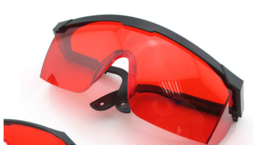
|
|
| Dark red | 200-540 nm @ 99.99% min | data not found | Recommended | 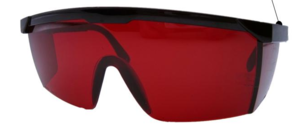
|
https://aliexpi.com/Fkns |
| Orange | 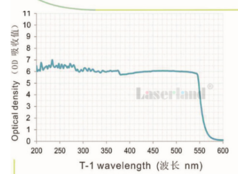
|
30% | Recommended | 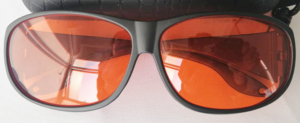
| |
| Yellow | 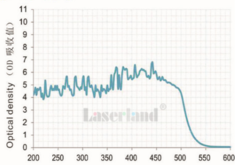
|
50% | Acceptable | 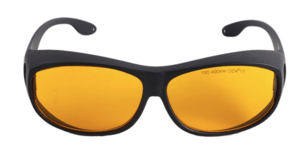
| |
| Light yellow | data not found | 85% | Avoid | 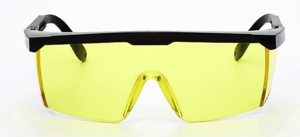
|
Red interior lighting
If you live in your own room, it is possible to use either RGB or pure red LED lights during dark period to avoid the inconvenience and/or discomfort from wearing goggles.
Computer screen colour filters
| Name | OS support | Automated? | |
|---|---|---|---|
| Redshift | Linux | Yes | |
| F.lux | Windows, Linux | Yes | |
| iOS&macOS native feature | iOS, macOS | No |
Note that, even with all the red colour filtered away, all screens, with the exception of OLED screens on some phones, will bleed backlight, which is white and can compromise your dark period. Depending on the quality and brightness setting of your screen, this may or may not be an issue.
Living with dark period
Using any of the above methods to achieve a dark period would virtually remove your ability to see all non-red lights. This can impair you ability to do work. However, there are some methods to mitigate this.
Monochromatic filters
Using red goggles or red filters can make it difficult to see certain colors on your screen. To solve this problem, you may wish to temporarily remove colors on your screen with a monochrome/greyscale filter. Here are some ways to do it:
On iOS and macOS, go to Accessibility > Display > Color Filters, turn on Color Filters and select “Greyscale”
On Android, open up Settings, then tap Digital Wellbeing & parental control, then choose Wind Down, you can set up a schedule for the evening, which will turn your screen greyscale for the scheduled time. Alternatively, go to Settings > Developer Options > Simulate colour space and choose Monochromacy. (For this, you need to have Developer Options enabled. link)
On GNOME, you can use the extension Desaturate All (remember to checkout to the feature branch) to turn your display monochrome with the click of a button. It is possible to use switch back and force between red-only and red-greyscale mode to make a rough estimate of the underlying colour (this also applies to other methods).
On Windows 10, you can use the key combination Ctrl + Windows + C to toggle a grayscale filter. This can be configured by finding Turn color filters on or off from the start menu.
Code editor colourschemes
Colour pickers
When there is a need to determine some colours with precision, it is best to use a colour picker program. These programs grabs a pixel from your screen and records the brightness value in each of the subpixels.
Related advice
Fasting period
It is recommended that you maintain a fasting period that covers the entirety of your dark period, as food is also an important zeitgeber, or circadian cue. Intermittent fasting has been anecdotally suggested to work well with polyphasic sleep. It is preferable to eat during the day rather than at night. A breakfast helps set the circadian day start.
Exercise
Intense exercise such as lifting and long-distance running should be avoided during dark period, as they might disrupt the circadian rhythm.[2] In addition, exercise may also disrupt sleep, which is usually in close proximity during dark period. However, during adaptation, it might be desirable to use exercise as a means to stay awake. Choose mild exercise routines and do not exercise for an extended period for this purpose.
References
- ↑ CIE TN 003:2015, Report on the First International Workshop on Circadian and Neurophysiological Photometry, 2013, published 2015
- ↑ Christopher A Wolff, Karyn A Esser, Exercise timing and circadian rhythms, Current Opinion in Physiology, Volume 10, 2019, Pages 64-69, ISSN 2468-8673, https://doi.org/10.1016/j.cophys.2019.04.020.
<translate>
| ||||||||||||||||||||||||||||||||
</translate>
